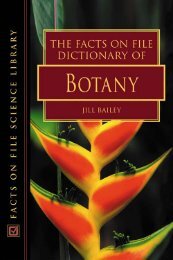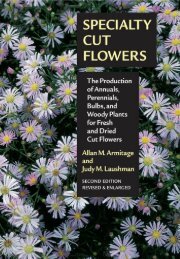Create successful ePaper yourself
Turn your PDF publications into a flip-book with our unique Google optimized e-Paper software.
Preface<br />
'Why should they care abom the histogenesis<br />
of the leaf, or adventitious roots? ... The public<br />
wants heart rransplanrs, a cure for AIDS,<br />
reversals of senility. lr doesn't care a hoot for<br />
plam Structures, and why shouJd it? Sure it can<br />
tolerate the people who study them ... They're<br />
relatively inexpensive too. It costs more lO keep<br />
twO convicts in Statesville than one botanist in<br />
his chair.'<br />
More Die by Heartbreak, Saul Bellow<br />
While Bellow's character Kenneth Trachtenbcrg<br />
may convincingly relegate the study of plam<br />
srrUClure to a backwater, it is a commonplace that<br />
we are all ultimately dependent on green planes<br />
for our survival on earth. Horticultural successes<br />
in increasing crop yields and developing new plam<br />
varieties emphasise the importance of plant<br />
physiology, biochemistry and molecular biology,<br />
for all of which the study of the green plant's<br />
internal form and internal structure is a<br />
prerequIsite.<br />
With the steadily increasing content of<br />
undergraduate and graduate biology courses, the<br />
proportion of a student's time devoted to plant<br />
morphology is inevitably teduced. There is no<br />
longer time for detailed study of the excellent and<br />
exhaustive texts in plant anatomy, and many find<br />
that plant structures are most easily understood<br />
when mainly described by annotated photographs<br />
and drawings.<br />
Such is the concept behind the present atlas:<br />
knowledge of pl:J.nt structure is fundamental to the<br />
study of plant science, and that knowledge has to<br />
be imparted clearly, briefly and precisely.<br />
Following an introductory chapter on the<br />
morphology of the vascular plant, there are se\'en<br />
chapters each dealing with a major aspect of plant<br />
structure. A comprehensive glossary of botanical<br />
terms used in the atlas is also included. The text<br />
for each chapter sets out rhe essential characteristics<br />
of the plant features described and makes<br />
extensive reference to appropriate iJiustrarions in<br />
the panicular chapter and elsewhere in the book.<br />
Each illustration is accompanied by a legend and<br />
salient features are numbered (not labelled) for<br />
maximum clarity, referencing the structures to a<br />
boxed key. It is hoped that these aspects of the<br />
atlas, together with the photographs and<br />
drawings, will prove attractive and useful to many<br />
readers.<br />
The atlas is intended for use in different ways<br />
by different readers. For the universiry or college<br />
srudent, the atlas is intended to be read either as a<br />
concise introductory text or as a revision guide in<br />
preparation for exams. For the professional<br />
instructor or for the researcher in academic life or<br />
in industry, ir is hoped the arias will provide a<br />
source of rapid reference. For the artist or the<br />
amateur student of natural hisrory, the intrinsic<br />
beauty of many plant specimens, in external form<br />
and under the microscope, is clearly shown in the<br />
photographs and drawings, arranged in sequence<br />
after the text in each chapter.<br />
The overall intention has been to provide a<br />
concise and highly iJJustrated summary of present<br />
knowledge of the structure of vascular plants,<br />
with particular emphasis on flowering plants.<br />
Bryan Bowes<br />
Bearsden, Glasgow<br />
September 1995<br />
7





